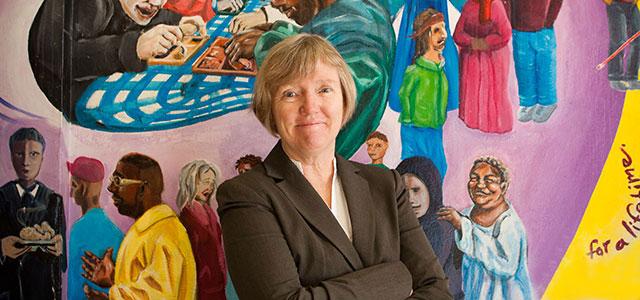
Patricia Dennehy (photo by Elisabeth Fall)
Dennehy Seeks Next Challenge
Since arriving at UCSF 24 years ago – and UC San Francisco School of Nursing 14 years ago – Patricia Dennehy has been a tireless fighter for San Francisco’s underserved patients and for expanding the leadership role of nurse practitioners in community clinics.
While practicing at Glide Health Services for the past 14 years, Dennehy was instrumental in making Glide the largest nurse-managed health center on the West Coast, widely recognized as one of the best community health practices in the country at providing access to quality health care for vulnerable populations. She championed wellness, prevention and living optimally with chronic illness, while becoming an early leader in the implementation of electronic health records and the use of data for managing both chronic disease and population health – all of which led to her receiving the 2012 James Irvine Foundation Leadership Award “for applying proven, innovative approaches to some of the state’s most difficult problems.”
In November, Dennehy announced she was stepping down both from her position at Glide and, as of January 31, 2014, from UCSF. Before doing so, she sat down with Science of Caring to reflect on her time here.
How did your career at UCSF begin?
When I first came, I worked in ambulatory care, as a nurse practitioner in the outpatient setting. I became the administrative manager in dermatology and otolaryngology. But at one point, the youngest of my three sons was hospitalized; I took six months off, and I knew I couldn’t go back to a 50-hour week for a while. Ultimately, I had an invitation to come work at the School as volunteer faculty and at Glide as a mental health manager. When I arrived at Glide, there was another director, and when she left, I took the role.
What was Glide like when you arrived?
We had a few rooms on the fourth floor, and we were a satellite clinic of Dr. Greg Fung, who was a great friend and a very generous person; he continued to be our medical director even after we received independent state licensure, which was necessary for our long-term goal of becoming a federally qualified health center. Around that time, we also joined the [San Francisco] Community Clinic Consortium. The consortium had a federal grant to serve the homeless, and we saw the opportunity to apply as a new homeless site when the government opened up new grants.
Getting that homeless grant from HRSA [Health Resources and Services Administration] was a huge change, because it meant we could get cost-based reimbursement – prospective payments that include services for this special population. Case management, recovery services, all get built into the billing rate. We were also successful with HRSA grants for nursing, which allowed us to expand our services.
The Irvine Foundation award spoke of the innovative approaches you implemented at Glide. Can you give some examples?
One thing we did early on was partner with Dr. Joanne Pohl at the University of Michigan School of Nursing on an AHRQ [Agency for Healthcare Research and Quality] grant to look at the implementation of electronic health records in nurse practitioner-run practices. Through that, we were able to invest a lot in data and quality improvement. That was a big step forward.
Also very early on – working with Karen Hill, Esker-D Ligon, Vicki Smith and Donald Tarver – we developed best practices for integrating early interventions for people with mental health issues into primary care. We participated in a large, statewide behavioral health integration program.
Our planning and grant strategy successfully put in place many cutting-edge programs – including being funded as a wellness center, which is an important element of the Affordable Care Act. I also directed an HRSA-funded project that created a postgraduate nurse practitioner residency in primary care, which is seen as a model in workforce development. Our work led to more national collaborations, including partnering with UC Irvine, UCLA and a large clinic system in Connecticut, which is led by Dr. Margaret Flinter, who developed the first nurse practitioner residency. Champions in the center for this program include Karla Ballesteros, Karen Hill, Larry Peiperl and JoAnne Saxe – and we received support from government grants and many different philanthropic groups.
Our most recent grant was a collaborative practice grant to set the stage for interprofessional teams to work together more effectively and spread the resources of all participants. We had pharmacy, therapists, psychiatry, internal medicine, nursing, substance abuse treatment, acupuncture and other holistic therapies involved – and our evaluator is health economist Dr. Joanne Spetz.
What are the advantages of a partnership between an institution like UCSF and a community clinic like Glide Health Services?
I think the partnership was especially important at the beginning, because there was such a rich array of skills that came from the School to help with quality and organization of care. There were so many great thinkers from the School involved, people who had great clinical expertise.
But I don’t know that a partnership like that will be the model going forward. Academic programs will find it harder in the future to have faculty-run practices meet the standards of the Affordable Care Act, primary care medical home and other regulations. It is a problem that is challenging both nursing and medicine in the traditional teaching models. Also, there’s always been a tension between the cultures; it’s a delicate balance, and while for the most part it’s been a healthy tension, Glide will replace my position with a Glide employee rather than UCSF faculty.
I think schools will need to find a way to continue to provide leadership, as well as opportunities for students to have terrific mentoring. Think of all the students we educated, the careers launched; if I had to say what I want to take away with me, it’s things like that: educating nurses, providing great care, testing and helping people see what’s possible in terms of new approaches – and working at the top of our game.
Over the years, you began taking a more prominent leadership role advocating for NPs in primary care and nurse-managed clinics. (Dennehy is currently on the board of the National Nursing Centers Consortium and has been invited to be a member of HRSA’s National Advisory Council on Nurse Education and Practice.) How do you see the future for NPs in primary care?
I think it’s going to go in the right direction – there will be resistance, blocks and bumps – but there have been huge strides. When you read the literature, I think there is almost undisputed agreement that nurse-managed care is here to stay.
Now, though, we have to coach ourselves about how to run the business. It’s not the same as an academic position, and it’s very different from taking care of people. We either have to get the skill set or be careful about hiring the right people. Not [acquiring these skills] could be the greatest threat, because we haven’t been motivated to understand the intricacies of running a business, keeping expenses and revenues in order – and I’m not sure the financial incentives will ever be there.
But we can’t move forward without these skills, and a lot of people have failed when they ignored them. I’m working with some groups now and it’s a challenge. Ultimately, though, I think it will work because there’s a need. For example, New Mexico is giving huge incentives to NPs to come there, and we’re going to see more of that in areas of need. So nurses have to stand up and participate in helping to make the big decisions, because they can bring a lot to the table, affecting how care is rendered and implementing new, innovative approaches.
As that happens, hopefully, training programs can step up and prepare more people for this type of work. They’ll try to open more medical schools, but most medical school graduates don’t really want to do the work of running a community clinic. It’s hard, messy work, and they’ve spent a lot of time and money on their education.
What’s next for you?
I’m not sure. I’ve been in conversations with San Francisco’s previous health director, who is now in Los Angeles, and I’ve been looking locally as well. I want to do something bigger than one clinic, where I could have a larger impact. If I could change the way larger numbers of people practice, that would be nice work.



